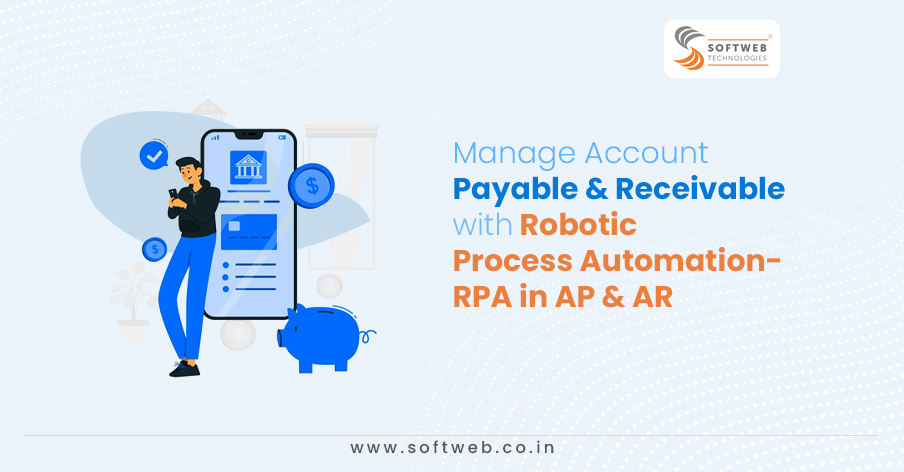Accounts Payable automation has progressed from basic task automation to comprehensive Procure-to-Pay (P2P) process automation solutions. Modern businesses now have access to advanced tools that manage data, optimize workflows, and integrate with other systems, enabling smoother invoice processing, enhanced data transparency, and transforming AP into a strategic asset.
Routine yet crucial tasks in accounting departments are often manual, time-consuming, and susceptible to human error, making them ideal for automation. The key challenge lies in selecting the right RPA for manufacturing, or accounting tailored to the specific needs of the business.
What is Robotic Process Automation (RPA)?
RPA is a software technology that mimics human actions through bots to perform routine tasks by interacting with applications in the same way a human would. It’s especially effective in industries that require high volumes of repetitive tasks, like accounting, or manufacturing where it can be used to streamline workflows, improve accuracy, and reduce human error.
Challenges in Traditional Accounts Payable and Receivable Management
Accounts Payable refers to the money a business owes its suppliers, while Accounts Receivable represents the money owed to the business by its clients. Traditionally, both processes are handled manually, often leading to several challenges:
- Manual Data Entry: Both AP and AR processes involve significant data entry, which is prone to errors and is time-consuming.
- Invoice Processing Delays: When processing invoices manually, delays can occur, leading to missed deadlines and strained relationships with suppliers.
- Duplicate Payments and Invoices: Without proper systems in place, there’s a risk of duplicate payments or invoices slipping through.
- Difficulty in Tracking Payments: Manual processes make it hard to track the status of payments, often resulting in cash flow issues.
- Human Errors: Errors like misplacing documents or incorrect data entry can lead to costly financial discrepancies.
How RPA Revolutionizes Accounts Payable and Receivable
Implementing Robotic Process Automation (RPA) can streamline invoice processing by automating the entry, verification, and approval workflows.
Invoice Entry
RPA bots can automatically retrieve emails containing digital invoices, copy the invoices, scan and apply GL codes to line items, and input the invoice data into the ERP system. For paper invoices, bots can integrate with invoice scanning software to automate the scanning process. In cases where the bot cannot scan an invoice or is unsure how to code a particular line item, it can be programmed to seek human intervention.
Invoice Processing Workflow
Invoice Matching
Manual two- and three-way matching is currently used to verify invoices, but due to the time-consuming nature of the process, only high-value invoices are matched. This may expose the system to potential losses from fraud and errors, while the Accounts Payable (AP) team is already operating at capacity.
With RPA, every invoice can be verified. Bots can flag discrepancies between invoices, purchase orders, or shipping receipts for further investigation by the AP team. As a result, the team can focus on addressing the root causes of these deviations by collaborating with vendors and internal stakeholders, rather than being overwhelmed by the matching process itself.
Approvals
Currently, invoice approvals are handled manually via email. After the AP clerk enters and verifies an invoice in the ERP system, the appropriate approvers are contacted by email. This method is slow, and there is a risk of emails being missed, lost, or forgotten.
RPA can automate the approval process by forwarding the invoice for approval after the verification stage. If the invoice passes verification, the bot sends it to the approver for sign-off and sends reminder emails if there’s no response within a set timeframe. Once approved, the invoice is forwarded to Finance for payment.
ERP Integration
While this process is partially automated, handling approvals by email remains manual due to the absence of an AP module in the current ERP system. Adding an AP module could fully automate the approval and payment process by allowing the RPA bots to interact directly with the system. However, concerns regarding the integration of an AP module are being considered.
By implementing RPA in Accounts Payable and Receivable, companies can automate repetitive tasks, allowing human employees to focus on more strategic tasks. Here’s how RPA can benefit both processes:
- Faster Invoice Processing
RPA can automate the entire invoice processing lifecycle—from data extraction to validation and final approval. With optical character recognition (OCR) technology, RPA bots can read invoices, extract relevant details such as vendor name, invoice number, amount, and due date, and then input this information into the financial system.
– Benefit: Faster processing times reduce the risk of late payments, ensuring businesses take advantage of early payment discounts and maintain good vendor relationships.
- Improved Accuracy
With manual processes, there’s always a risk of human error, especially when handling hundreds or thousands of invoices. RPA minimizes these errors by automating data entry and ensuring that all information is accurately captured and validated.
– Benefit: Reduced errors prevent issues like overpayments, underpayments, and duplicate payments, improving financial reporting accuracy.
Account Reconciliations with RPA
RPA bots are capable of performing real-time account reconciliations, ensuring that records are accurately aligned. The bot can automate the process by downloading daily bank statements, logging into SAP to compare them with internal records, and generating reports highlighting any discrepancies or missing transactions. This approach helps maintain a precise audit trail of all financial transactions and journal entries, ensuring timely reconciliation.
Adding New Vendors
The current manual process for vendor alignment or onboarding new vendors is time-consuming and diverts employees from focusing on higher-value tasks. An RPA bot can streamline this process by automatically sending new vendors a form to complete. Once the vendor submits the form, the bot reviews it for completeness, sets up the vendor in the ERP, and adds all necessary details.
Attended vs. Unattended RPA
There can be concerns about losing control over critical processes like invoice verification when automating accounts payable. RPA solutions come in two forms: attended and unattended, each suitable for different levels of automation.
– Attended RPA requires human involvement, where tasks are manually triggered, and human decision-making is needed at key points. This type of automation is ideal for mission-critical tasks such as invoice entry, verification, and supplier payments.
– Unattended RPA operates without human intervention, automatically completing end-to-end tasks like report generation. These processes are well-suited for non-critical functions that don’t require constant oversight.
While RPA offers numerous advantages for automating accounts payable processes, for some businesses, a tailored end-to-end solution—like Softweb’s myPA—may be more appropriate to meet the unique needs of AP teams.
Key Benefits of RPA in Accounts Payable and Receivable
- Cost Savings
Automating AP and AR reduces labour costs by eliminating the need for manual processing. Additionally, it helps avoid the financial impact of errors and late payments.
- Compliance and Risk Reduction
RPA ensures compliance with internal controls and external regulations. All processes are auditable, and every step taken by an RPA bot is recorded, providing a clear trail for compliance purposes.
- Enhanced Vendor and Client Relationships
By automating processes, businesses can ensure they meet payment deadlines and avoid delays in client invoicing. This fosters better relationships with suppliers and clients alike.
- Increased Employee Productivity
With RPA handling repetitive tasks, employees can focus on more value-added activities like analysis, strategy, and relationship building. This leads to higher job satisfaction and better retention rates.
- Reduced Processing Time
RPA can significantly reduce the time it takes to process payments and invoices, allowing businesses to close their books faster and improve financial transparency.
Implementation of RPA in AP and AR: Best Practices
Implementing RPA in accounts payable (AP) and receivable (AR) can transform financial operations by automating repetitive, rule-based tasks like invoice processing and payment matching.
Key best practices include identifying suitable processes for automation, selecting the right RPA tool with seamless integration and OCR support, involving stakeholders early for smoother implementation, and continuously monitoring and optimizing bot performance.
The future of AP and AR with RPA includes AI-based predictive analytics and the integration of blockchain and smart contracts, enhancing transparency and decision-making in financial transactions while optimizing cash flow.


